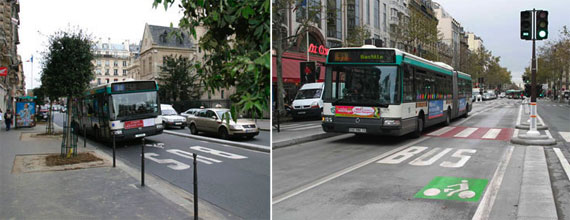Does New York BRT Need Cops and Cameras, or Just Concrete?

Not to stoke the center vs. curbside lane debate, but here are a couple of shots of the Paris Mobilien Bus Rapid Transit system. As pointed out by Streetsbloggers, the Mobilien uses both types of lanes. And unlike New York’s Select Bus Service, Paris BRT relies on preventative physical separation between buses and auto traffic, mitigating the need for more intensive enforcement measures like cameras, ticket agents and tow trucks.
Back in October of 2006, Streetsblog’s Aaron Naparstek noted what could be the most substantial difference between New York’s plan and successful systems in Paris and Bogotá — a sentiment echoed following this week’s SBS debut.
While New York City’s BRT system will be a significant
advance over what we have now, the lack of physical separation has the
potential to be a system-breaker. Without physical separation,
that single guy in the double-parked SUV may still have the ability to
delay the morning commute of 80 New Yorkers. Sure, Mr. SUV gets a $350
ticket (if he’s not a government employee). You’re still late for work.
Concrete curbs don’t know from the likes of David Gantt. They
don’t go away when budgets come up short. They enforce 24/7. Yet New York will depend solely on
police and, should Albany someday grant permission, cameras to chase
drivers out of BRT lanes. Will it work? If so, how well, and for how
long?
Photos: Aaron Naparstek